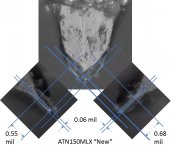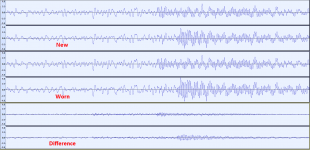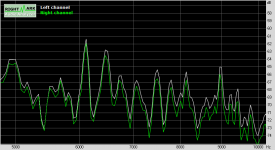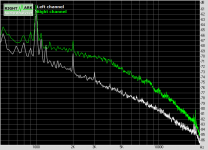Recently I had a couple of stylii send off to be imaged as a favour. Both AT microlines, but one well worn (audibly so) and the other under 10 hours. After sticking them under the microscope a track was recorded with each so there is a record of what a worn out stylus sounds like. But we were mulling what sort of audio analysis might be useful. If I can work out how to operate dropbox I'll post links here but in the meantime any ideas what might be of use?
What was ripped and was it the same for both stylii?
I would look at the frequency spectrum, and noise floor.
Maybe compare L-R amplitude maxima and minima to determine whether or not separation level is affected?
Normally I say distortion, but on music signal that's going to be impossible unless gross in which case the spectrum would be affected.
Without knowing the nature of the material ripped it's hard to guess what else might be useful.
I would look at the frequency spectrum, and noise floor.
Maybe compare L-R amplitude maxima and minima to determine whether or not separation level is affected?
Normally I say distortion, but on music signal that's going to be impossible unless gross in which case the spectrum would be affected.
Without knowing the nature of the material ripped it's hard to guess what else might be useful.
What about a square wave analysis. A worn stylus should show a drop off in HF. With a square wave it would be immediately obvious.
Kevin: This was a music recording. Lead in groove followed by (classical) music. When I get the stylus back later in the year I can try test records but this was done as an interest thing as not many recorded comparisons of new vs on last legs out there.
Note even when worn to the point of touching the groove bottom the contact patch is still only .2mil wide. HF should not be affected (for a given value of should).
Note even when worn to the point of touching the groove bottom the contact patch is still only .2mil wide. HF should not be affected (for a given value of should).
I would say a spectral analysis of each file, plus noise floor would be a good place to start.
For some reason this reminded me of our ill-fated test record.. Darn!
For some reason this reminded me of our ill-fated test record.. Darn!
For some reason this reminded me of our ill-fated test record.. Darn!
Right, though toward the end I got the impression that this would have not gotten any special treatment from any mastering house.
Post the files and turn us loose on them. Plenty of people here with different software skills. Let's see what gets pulled out of the mix.
What about a square wave analysis. A worn stylus should show a drop off in HF. With a square wave it would be immediately obvious.
Would you mind sharing your idea of how a square wave might be engraved onto a record?
Best regards!
It's engraved as a triangle wave, which a velocity sensing cartridge turns into a square wave.
Dropbox is not strong in this one, so here are the original links
New Stylus: https://www.dropbox.com/s/675xn437xn0hz ... 3.wav?dl=0
Worn Stylus: https://www.dropbox.com/s/h2mqqj36xsz0l ... 3.wav?dl=0
Comparisons someone has done already on the music section does suggest a very increased noise level, whereas the lead in grooves overlap almost perfectly. This I think is a sign of the stylus bottom out on modulated grooves.
Dropbox is not strong in this one, so here are the original links
New Stylus: https://www.dropbox.com/s/675xn437xn0hz ... 3.wav?dl=0
Worn Stylus: https://www.dropbox.com/s/h2mqqj36xsz0l ... 3.wav?dl=0
Comparisons someone has done already on the music section does suggest a very increased noise level, whereas the lead in grooves overlap almost perfectly. This I think is a sign of the stylus bottom out on modulated grooves.
Attachments
Interesting. Even via laptop speakers the noise increase with the worn one is quite obvious but also the treble curiously seems more muted and a bit phasey almost. Not as incisive.
That's a bit of a contradiction, more noise and less treble, but it's how it sounds to me. The noise isn't just the background groove noise but background 'hiss' such as it is. That sounds higher with the worn yet the treble on the instruments more muted.
That's a bit of a contradiction, more noise and less treble, but it's how it sounds to me. The noise isn't just the background groove noise but background 'hiss' such as it is. That sounds higher with the worn yet the treble on the instruments more muted.
The wear done to the records is probably increased when using a worn stylus as well.
What would be handy is a usb imaging device (or anything) to be able and witness the wear of the stylus more readily.
What would be handy is a usb imaging device (or anything) to be able and witness the wear of the stylus more readily.
Would you be able to measure wear with a test record and a scope? Would be great if there was an easier and better way to keep track of record wear. I have quite a few cartridges and simply counting the hours used would be a pain as I swap out cartridges regularly.
Bill,Comparisons someone has done already on the music section does suggest a very increased noise level, whereas the lead in grooves overlap almost perfectly. This I think is a sign of the stylus bottom out on modulated grooves.
I failed to find differences in noise spectra between new and worn, but I took a 200msec fragment of a loud passage at 3/4 of the recording and time aligned new and worn as best as I could.
Then I took the difference of both, see image below.
Longer periods are not possible because of speed fluctuations of the TT.
The largest differences can be seen in the higher frequencies.
Hans
Attachments
Bill,
If you would have a recording of a test record with a 1Khz tone, it will be much easier to to see what the worn needle is doing to noise and distortion.
Hans
If you would have a recording of a test record with a 1Khz tone, it will be much easier to to see what the worn needle is doing to noise and distortion.
Hans
Hi Hans,
Sadly a minor tragedy has struck. The next step was to lap the diamond so that it cleared the groove base again. During lapping it broke, so we can't get any more data out this. I'll just have to wear out another microridge and try again. It'll only take me about 6 years...
Sadly a minor tragedy has struck. The next step was to lap the diamond so that it cleared the groove base again. During lapping it broke, so we can't get any more data out this. I'll just have to wear out another microridge and try again. It'll only take me about 6 years...
Would you be able to measure wear with a test record and a scope?.
Stylus Wear Study- Vinyl Engine gives some interesting information, which indicates that, at least with a linear tracker exceedingly long life is possible. End of life should show a reduction in HF response, but it's profile specific (I believe).
Hi Hans,
Sadly a minor tragedy has struck. The next step was to lap the diamond so that it cleared the groove base again. During lapping it broke, so we can't get any more data out this. I'll just have to wear out another microridge and try again. It'll only take me about 6 years...
Wow that’s a pitty.
But doesn’t it imply that in the meantime you suddenly have all the time in the world to finalise your MM and MC hardware projects. 😀
Hans
Goodness no. This was all being done by Ray in California. I'm still staring balefully at unfinished projects 🙂
Tough break Bill - literally!
I went over the New and Worn files to find differences. I assume that you left everything the same and just swapped the stylus.
This is the music frequency response of the 2 stylii. New is left (white) and worn is right (green) This is just the music section. Frequencies not shown are virtually identical.
GRAPH 1
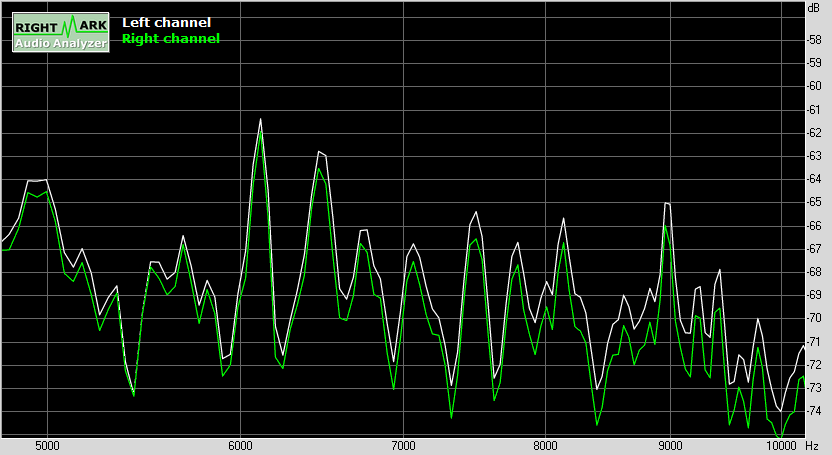
This is the frequency response of quiet groove amplified 26 dB. Again new is left, worn is right.
GRAPH 2
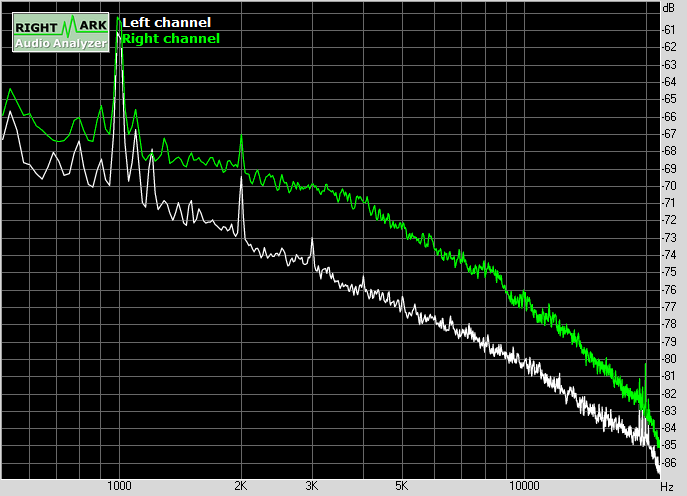
As far as I can hear and see, the new stylus has slightly better channel balance, better top end response and lower noise in the ear's sensitive range.
Otherwise very similar.
Cheers
I went over the New and Worn files to find differences. I assume that you left everything the same and just swapped the stylus.
- Remarkably clean and low noise. Tells me how far I have to go with mine.
- Average level very close between new and worn. About 1/3 dB on the left channel and 1.33 dB on the right
- New is better balanced between channels.
- Out of phase levels (side channels) equal between new and worn despite the balance difference
- Quiet groove noise only averages 0.4dB lower on new stylus. However, spectrum different
- Frequency response almost identical up to ~5 kHz. Then new has better HF response. See graph 1
- Quiet groove noise spectrum noticeably different. See graph 2
This is the music frequency response of the 2 stylii. New is left (white) and worn is right (green) This is just the music section. Frequencies not shown are virtually identical.
GRAPH 1
This is the frequency response of quiet groove amplified 26 dB. Again new is left, worn is right.
GRAPH 2
As far as I can hear and see, the new stylus has slightly better channel balance, better top end response and lower noise in the ear's sensitive range.
Otherwise very similar.
Cheers
Attachments
- Home
- Source & Line
- Analogue Source
- analysing worn vs new stylus rips


